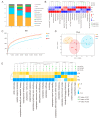The Protective Effects of 2'-Fucosyllactose against E. Coli O157 Infection Are Mediated by the Regulation of Gut Microbiota and the Inhibition of Pathogen Adhesion
- PMID: 32369957
- PMCID: PMC7282266
- DOI: 10.3390/nu12051284
The Protective Effects of 2'-Fucosyllactose against E. Coli O157 Infection Are Mediated by the Regulation of Gut Microbiota and the Inhibition of Pathogen Adhesion
Abstract
As the richest component in human milk oligosaccharides (HMOs), 2'-fucosyllactose (2'-FL) can reduce the colonization of harmful microbiota in vivo, thus lowering the risk of infection; however, the mechanism for this is still unclear. In this study, a model of Escherichia coli O157 infection in healthy adult mice was established to explore the effect of 2'-FL intervention on E. coli O157 colonization and its protective effects on mice. The results showed that 2'-FL intake reduced E. coli O157 colonization in mice intestine by more than 90% (p < 0.001), and it also reduced intestinal inflammation, increased the content of fecal short-chain fatty acids, and enhanced intestinal barrier function. These beneficial effects were attributed to the increased expression of mucins such as MUC2 (increased by more than 20%, p < 0.001), and inhibition of E. coli O157 cell adhesion (about 30% reduction, p < 0.001), and were associated with the modulation of gut microbiota composition. 2'-FL significantly increased the abundance of Akkermansia, a potential probiotic, which may represent the fundamental means by which 2'-FL enhances the expression of mucin and reduces the colonization of harmful bacteria. The current study may support the use of 2'-FL in the prevention of foodborne pathogen infections in human.
Keywords: 2’-fucosyllactose; Akkermansia; E. coli O157; gut microbiota; reduced colonization.
Conflict of interest statement
The authors declare no conflicts of interest.
Figures







Similar articles
-
Human milk oligosaccharides mitigate infant diarrhea and anxiety-like behaviors via gut microbiota modulation in an EPEC O127 infection model.Food Funct. 2025 Jul 14;16(14):5757-5770. doi: 10.1039/d5fo01854d. Food Funct. 2025. PMID: 40548525
-
Bacillus amyloliquefaciens TL106 protects mice against enterohaemorrhagic Escherichia coli O157:H7-induced intestinal disease through improving immune response, intestinal barrier function and gut microbiota.J Appl Microbiol. 2021 Jul;131(1):470-484. doi: 10.1111/jam.14952. Epub 2020 Dec 18. J Appl Microbiol. 2021. PMID: 33289241
-
α1,2-Fucosyllactose Does Not Improve Intestinal Function or Prevent Escherichia coli F18 Diarrhea in Newborn Pigs.J Pediatr Gastroenterol Nutr. 2017 Feb;64(2):310-318. doi: 10.1097/MPG.0000000000001276. J Pediatr Gastroenterol Nutr. 2017. PMID: 27243420
-
Perspectives on super-shedding of Escherichia coli O157:H7 by cattle.Foodborne Pathog Dis. 2015 Feb;12(2):89-103. doi: 10.1089/fpd.2014.1829. Epub 2014 Dec 16. Foodborne Pathog Dis. 2015. PMID: 25514549 Review.
-
Human Milk Oligosaccharides: 2'-Fucosyllactose (2'-FL) and Lacto-N-Neotetraose (LNnT) in Infant Formula.Nutrients. 2018 Aug 24;10(9):1161. doi: 10.3390/nu10091161. Nutrients. 2018. PMID: 30149573 Free PMC article. Review.
Cited by
-
Effects of Bifidobacterium with the Ability of 2'-Fucosyllactose Utilization on Intestinal Microecology of Mice.Nutrients. 2022 Dec 19;14(24):5392. doi: 10.3390/nu14245392. Nutrients. 2022. PMID: 36558551 Free PMC article.
-
Sodium Humate Alleviates Enterotoxigenic Escherichia coli-Induced Intestinal Dysfunction via Alteration of Intestinal Microbiota and Metabolites in Mice.Front Microbiol. 2022 Mar 25;13:809086. doi: 10.3389/fmicb.2022.809086. eCollection 2022. Front Microbiol. 2022. PMID: 35401451 Free PMC article.
-
Necrotizing enterocolitis: Bench to bedside approaches and advancing our understanding of disease pathogenesis.Front Pediatr. 2023 Jan 11;10:1107404. doi: 10.3389/fped.2022.1107404. eCollection 2022. Front Pediatr. 2023. PMID: 36714655 Free PMC article. Review.
-
Metagenome Analysis of the Bacterial Characteristics in Invasive Klebsiella Pneumoniae Liver Abscesses.Front Cell Infect Microbiol. 2022 Jul 15;12:812542. doi: 10.3389/fcimb.2022.812542. eCollection 2022. Front Cell Infect Microbiol. 2022. PMID: 35909970 Free PMC article.
-
Digestion, fermentation, and pathogen anti-adhesive properties of the hMO-mimic di-fucosyl-β-cyclodextrin.Food Funct. 2021 Jun 8;12(11):5018-5026. doi: 10.1039/d1fo00830g. Food Funct. 2021. PMID: 33954318 Free PMC article.
References
-
- Mao X., Wang J., Hang Y., Zhang Y., Yu H., Li Z., Pan L., Dai Z. A human milk oligosaccharide, 2’-fucosyllactose, enhances the immunity in mice fed an infant formula milk diet. Int. Dairy J. 2019;98:38–43. doi: 10.1016/j.idairyj.2019.07.001. - DOI
MeSH terms
Substances
Grants and funding
LinkOut - more resources
Full Text Sources
Medical
Research Materials
Miscellaneous

